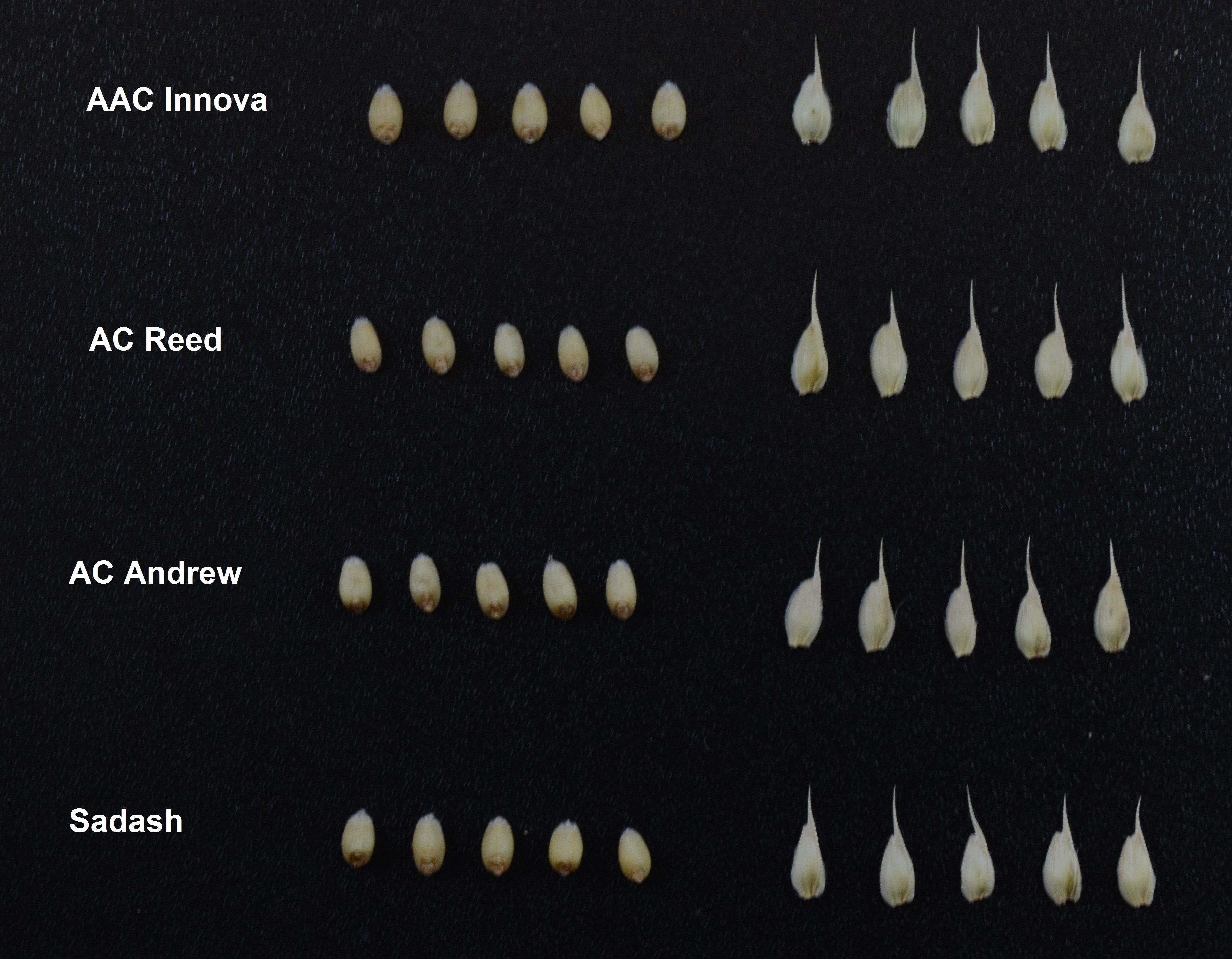AAC Innova
| Denomination: | 'AAC Innova' |
|---|---|
| Botanical Name: | Triticum aestivum |
| Applicant/Holder: |
Agriculture & Agri-Food Canada, Lethbridge Lethbridge Research Centre, 5403 - 1 Avenue, South P.O. Box 3000 Lethbridge, Alberta T1J 4B1 Canada |
| Breeder: |
Harpinder S. Randhawa, Agriculture & Agri-Food Canada, Lethbridge, Alberta |
| Agent in Canada: |
Agriculture & Agri-Food Canada Office of Intellectual Property and Commercialization c/o Shannon Whyte 107 Science Place Saskatoon, Saskatchewan S7N 0X2 Canada Tel: (204) 999-9887 |
| Application Date: | 2013-03-27 |
| Application Number: | 13-7982 |
| Grant of Rights Date: | 2015-05-14 |
| Certificate Number: | 5020 |
| Grant of Rights Termination Date: | 2035-05-14 |
Variety Description
Varieties used for comparison: 'AC Reed', 'AC Andrew' and 'Sadash'
Summary: The frequency of plants with recurved flag leaves is low in 'AAC Innova' whereas it is absent or very low in the reference varieties. The intensity of anthocyanin colouration of the flag leaf auricles of 'AAC Innova' is weak whereas it is absent or very low on the reference varieties. The flag leaf of 'AAC Innova' is wider than that of 'AC Reed' and 'AC Andrew'. 'AAC Innova' is later heading than the reference varieties. At maturity, the plants of 'AAC Innova' are taller than those of 'AC Reed'. The shoulder of the lower glume of 'AAC Innova' has a sloping to slightly sloping shape whereas it is elevated on 'Sadash'. The lower glume beak of 'AAC Innova' is long whereas it is short on 'AC Reed', medium length on 'AC Andrew' and short to medium length on 'Sadash'.
Description:
PLANT: soft white spring type, erect growth habit at the 5 to 9 tiller stage, heads emerge mid-season, matures mid-season
SEEDLING: absent or very weak intensity of anthocyanin colouration of coleoptile, glabrous lower leaf sheaths and blades
FLAG LEAF: low frequency of plants with recurved/drooping flag leaves, weak anthocyanin colouration of auricles, absent or very weak glaucosity of sheath and lower side of leaf blade, glabrous blade and sheath
CULM NECK: absent or very sparse density of hairiness of uppermost node, absent or very weak glaucosity, straight
STRAW: thin pith in cross section, no anthocyanin colouration at maturity
SPIKE: absent to very weak glaucosity, tapering shape in profile, dense, white at maturity, erect attitude, medium hairiness of convex surface of apical rachis segment
AWNS: shorter than length of spike, white
LOWER GLUME: medium length, glabrous
LOWER GLUME SHOULDER: medium width, sloping to slightly sloping shape
LOWER GLUME BEAK: long, strongly curved
KERNEL: white, medium size, medium length and width, oval shape, rounded cheek, medium length brush hairs, medium width and depth of crease
GERM: medium size, round in shape
AGRONOMIC CHARACTERISTICS: good resistance to shattering
DISEASE REACTION: resistant to Leaf Rust (Puccinia triticina) and Stripe Rust (Puccinia striiformis), moderately resistant to Stem Rust (Puccinia graminis f. sp. tritici), moderately susceptible to Fusarium Head Blight (Fusarium graminearum, Fusarium species) and Kernal Black Point (principally caused by Alternaria alternata), and susceptible to Loose Smut (Ustilago tritici)
Origin & Breeding History: 'AAC Innova' (experimental designation GP47) was derived from the cross 'AC Andrew' / 'N9195' conducted in 2001 at the Agriculture and Agri-Food Canada Lethbridge Research Centre, Lethbridge, Alberta using a modified bulk breeding technique. F1 plants were increased in the greenhouse in the fall of 2001 with the F2 seeds grown out in bulk plots in 2002. F3 rows were grown out in Lincoln, New Zealand during the winter of 2002-2003. One F4 line was grown in an initial yield trial in Lethbridge in 2003. Based on superior agronomic characteristics, 4 heads were selected and grown in Lincoln, New Zealand in 2003-2004. In spring of 2004, one F6 line was grown in a yield trial in Lethbridge. Based on excellent yield and agronomic traits, eight head selections were grown in Leeston, New Zealand during the winter of 2004-2005. In 2005, one F8 line was grown in a preliminary yield trial in Lethbridge and was advanced to a B test in 2006 and grown in Lethbridge, Vauxhall and Bow Island. In 2007, this line was evaluated in the Ethanol B test at six locations throughout western Canada. Based on its favourable agronomic performance and disease resistance, it was evaluated in the General Purpose Wheat Cooperative Registration trial as GP47 from 2008-2010.
Tests & Trials: Tests and trials were conducted in 2012 and 2013 in Lethbridge, Alberta. Plots consisted of 4 rows per plot with a row length of 3.0 metres and a row spacing of 23 cm. There were 3 replicates arranged in a RCB design. Measured characteristics were based on a minimum of 30 measurements per variety per year.
Comparison tables for 'AAC Innova' with reference varieties 'AC Reed', 'AC Andrew' and 'Sadash'
Flag leaf width (cm)
| 'AAC Innova' | 'AC Reed' | 'AC Andrew' | 'Sadash' | |
|---|---|---|---|---|
| mean 2012 | 2.07 | 1.62 | 1.97 | 1.99 |
| std. deviation 2012 | 0.11 | 0.13 | 0.18 | 0.17 |
| mean 2013 | 1.82 | 1.55 | 1.60 | 1.90 |
| std. deviation 2013 | 0.13 | 0.16 | 0.12 | 0.13 |
Days to heading
| 'AAC Innova' | 'AC Reed' | 'AC Andrew' | 'Sadash' | |
|---|---|---|---|---|
| mean 2012 | 66 | 59 | 63 | 63 |
| mean 2013 | 68 | 62 | 65 | 66 |
Plant height (cm)
| 'AAC Innova' | 'AC Reed' | 'AC Andrew' | 'Sadash' | |
|---|---|---|---|---|
| mean 2012 | 92.30 | 90.37 | 96.20 | 95.21 |
| std. deviation 2012 | 2.18 | 1.92 | 2.55 | 1.47 |
| mean 2013 | 109.33 | 94.90 | 100.87 | 106.23 |
| std. deviation 2013 | 3.44 | 2.23 | 2.24 | 2.67 |
Click on image for larger view

Wheat: 'AAC Innova' (top) with reference varieties 'AC Reed' (centre top), 'AC Andrew' (centre bottom) and 'Sadash' (bottom)
- Date modified: